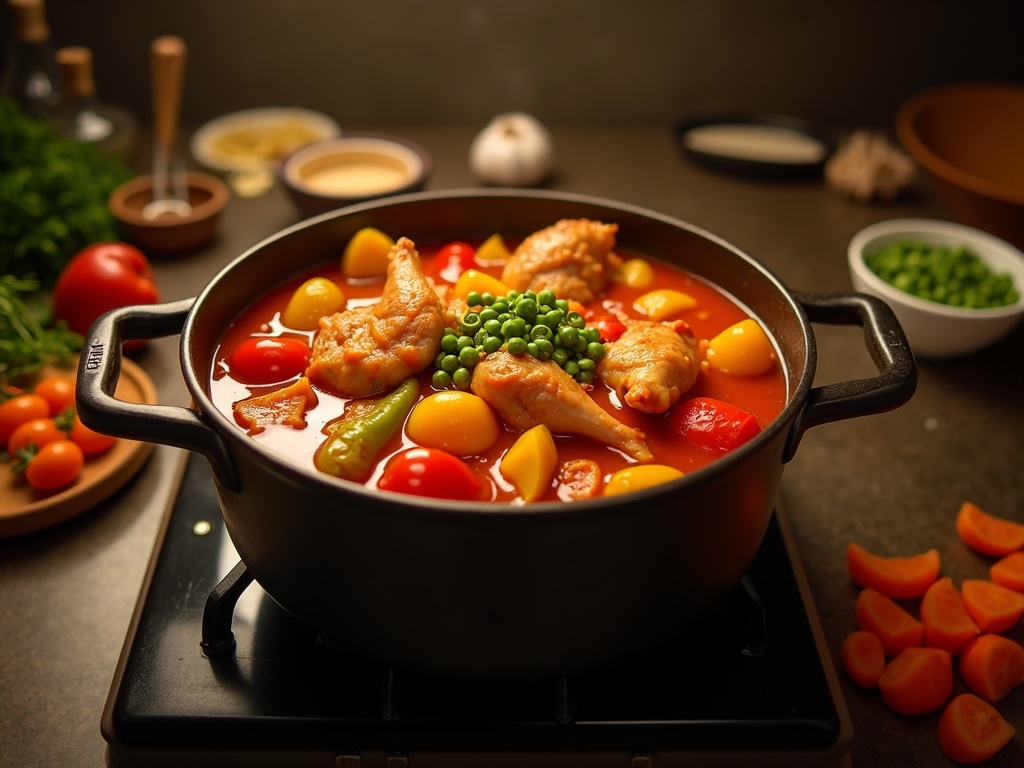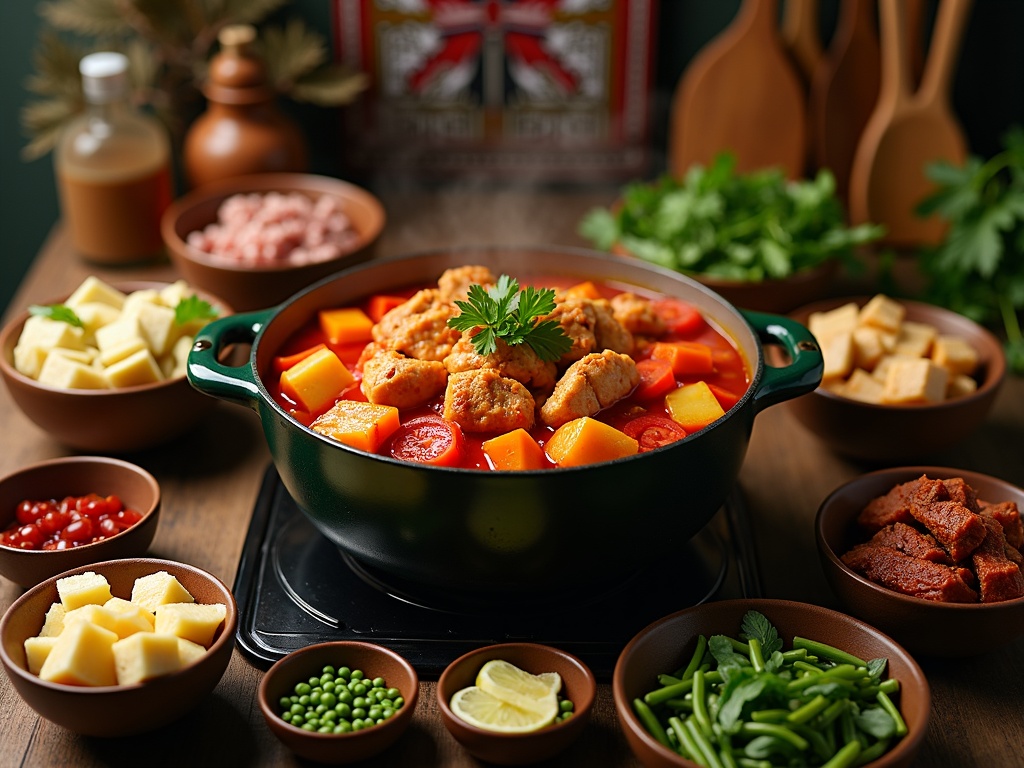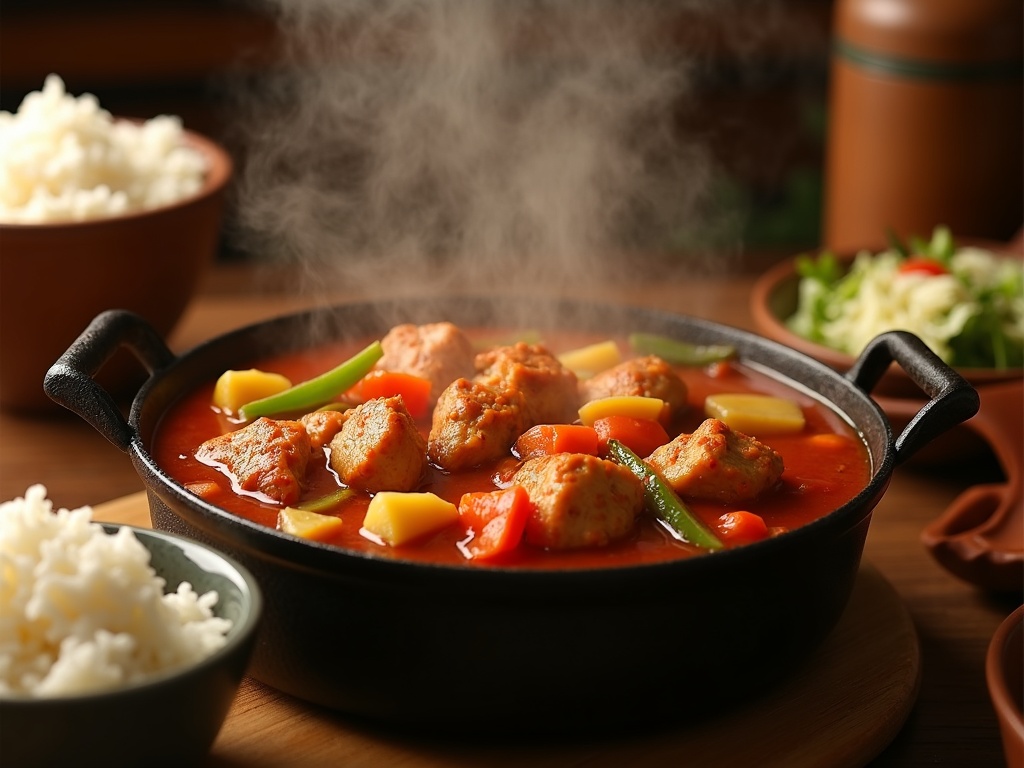Chicken Afritada stands as a beloved Filipino comfort food that clearly shows Spanish colonial influence through its savory tomato-based sauce and colorful mix of vegetables. This vibrant one-pot dish pairs tender chicken pieces with potatoes, carrots, and bell peppers, creating a balanced flavor profile that’s made it essential for family gatherings across the Philippines.
Find In This Article
Key Takeaways
- The dish gets its name from the Spanish word ‘fritada’ meaning ‘fried,’ referring to the initial searing of chicken before simmering in sauce.
- Traditional ingredients include chicken, potatoes, carrots, bell peppers, and sometimes green peas, creating a nutritionally balanced meal with approximately 300-400 calories per serving.
- The cooking process takes about 60 minutes total, with proper timing being crucial to achieve perfectly tender chicken and vegetables that retain their shape.
- The recipe adapts easily, with popular variations including different proteins like pork, beef, or tofu, and regional adaptations that may add coconut milk or additional seasonings.
- Chicken Afritada holds significant cultural importance in Filipino society, often featured at celebrations and serving as a way for overseas Filipinos to maintain a connection to their heritage.
What Makes Chicken Afritada a Filipino Favorite
Chicken Afritada stands out as a beloved Filipino comfort food that graces many family dinner tables throughout the Philippines. This vibrant dish captures the essence of Filipino cooking with its savory tomato-based sauce and colorful vegetables. The name actually has historical roots, deriving from the Spanish word ‘fritada’ meaning ‘fried’ – a nod to the initial cooking process where chicken pieces are seared before simmering.
The Perfect Balance of Flavors and Nutrition
I’ve found that Chicken Afritada strikes an ideal balance between flavor and nutrition. A typical serving contains approximately 300-400 calories, making it a reasonably healthy option for a main course. The dish features tender chicken pieces cooked slowly until they absorb the rich tomato sauce. This cooking method allows the meat to become incredibly tender while developing deep flavor.
What makes this dish truly special is the colorful medley of vegetables that complement the protein:
- Potatoes that soak up the savory sauce
- Carrots that add natural sweetness
- Bell peppers that provide a hint of freshness
- Sometimes green peas for extra color and texture
The sauce itself deserves special mention – a tomato-based creation enhanced with garlic, onions, and sometimes a touch of fish sauce for that unmistakable Filipino umami.
Cultural Significance and Serving Traditions
Chicken Afritada beautifully showcases the Spanish colonial influence on Filipino cuisine. The cooking techniques and use of tomatoes reflect the 300+ years of Spanish presence in the Philippines, resulting in a dish that feels authentically Filipino while honoring its historical roots.
Traditionally, Afritada is served over a bed of steaming white rice, which provides the perfect canvas for soaking up the flavorful sauce. I’ve noticed that many Filipino families consider this dish a staple for gatherings and celebrations. It’s typically prepared in large batches, making it perfect for feeding extended family members during weekend get-togethers.
The beauty of chicken-based Filipino dishes like Afritada is their adaptability. While maintaining its core elements, each household often has its own unique variation – some adding a hint of sweetness with a touch of sugar, others incorporating liver spread for richness, creating a dish that evolves while staying true to its roots.
The Perfect Way to Cook It
I’ve found that chicken afritada, with its rich tomato sauce and tender vegetables, needs about 60 minutes from start to finish. This includes 20 minutes of preparation and 30-40 minutes of actual cooking time. The beauty of this Filipino classic lies in its simple cooking method that delivers complex flavors.
Preparation and Marination
Before heating any oil, I always marinate the chicken pieces in soy sauce and minced garlic for at least 15 minutes. This quick marination makes a huge difference in the final flavor profile. While the chicken soaks up these flavors, I use this time to dice the vegetables and prepare the other ingredients.
The key vegetables to prepare include:
- Bell peppers (red and green for color contrast)
- Potatoes, cut into medium chunks
- Carrots, sliced into rounds
- Green peas (fresh or frozen)
Once everything is prepped, I heat a large pot or deep skillet over medium heat. A heavy-bottomed pot works wonderfully for creating rich chicken dishes like afritada, as it distributes heat evenly and prevents burning.
The One-Pot Cooking Method
I start by sautéing minced garlic until fragrant (about 30 seconds), then add diced onions and cook until translucent (approximately 2-3 minutes). Next comes the marinated chicken, which I brown on all sides for about 5-7 minutes. This browning step is crucial as it develops deep flavor compounds that will infuse the entire dish.
After browning the chicken, I add tomato sauce or fresh diced tomatoes and let them break down for about 5 minutes. Then I pour in chicken broth, cover the pot, and let everything simmer for 15 minutes until the chicken is nearly tender.
At this point, I add the potatoes and carrots since they need more cooking time than the bell peppers. These root vegetables simmer for about 10 minutes until they’re halfway cooked. Only then do I add the bell peppers and green peas, allowing them to cook for the final 5-7 minutes.
The one-pot method not only makes chicken cooking easier but also creates a beautiful amalgamation of flavors as each ingredient contributes to the sauce. By the time everything is done, the sauce should have thickened slightly and turned into a vibrant red-orange color.
I’ve found that timing is critical with this dish. Overcooking can lead to mushy vegetables and dry chicken, while undercooking might leave the potatoes firm and the chicken unsafe to eat. The total simmering time of 30 minutes (15 for the chicken alone, 10 with root vegetables, and 5-7 with the remaining vegetables) produces perfectly tender chicken and vegetables that still hold their shape.
For the final touch, I adjust the seasoning with salt and pepper, and sometimes add a dash of fish sauce for extra depth. The resulting dish should have a savory-sweet profile with a hint of acidity from the tomatoes.
This cooking method ensures all components cook properly while creating a harmonious sauce that ties everything together. As an added bonus, the one-pot approach means minimal cleanup afterward – always a welcome feature for any chicken recipe in my kitchen.

Traditional Ingredients and Their Benefits
Chicken afritada starts with its star protein component. I’ve found that using chicken provides lean protein that’s essential for muscle repair and growth. The tender meat absorbs the rich tomato sauce perfectly, creating a flavorful base for this classic Filipino dish. When selecting chicken for your simple chicken breast recipes, choose pieces with the bone in for added flavor.
Potatoes serve as the hearty carbohydrate component in this dish. They not only provide/sustained energy but also help thicken the sauce naturally as they cook. The starch from potatoes gives afritada its characteristic consistency that’s perfect for serving over rice.
Fresh Vegetable Components
Fresh vegetables elevate chicken afritada from a simple stew to a nutritional powerhouse. These ingredients add layers of flavor while boosting the dish’s health benefits:
- Bell peppers contain vitamin C and antioxidants that support immune function
- Carrots provide beta-carotene for eye health and vibrant color
- Tomatoes offer lycopene and create the base for the signature red sauce
- Green peas add a pop of sweetness and additional protein
I can’t stress enough the importance of using fresh produce when preparing afritada. The vegetables should be firm and brightly colored for optimal flavor and nutritional content. The difference between fresh and older produce is immediately noticeable in the final dish.
While preparing your chicken stock recipe for afritada, remember that regional variations exist throughout the Philippines. Northern regions might include more ginger and less tomato, while southern variations often incorporate coconut milk for added richness. Some families add olives or pickles for a salty contrast, while others keep it simple.
The seasoning foundation typically includes garlic, onions, and black pepper, with fish sauce (patis) providing the salty element. These aromatics infuse the butter chicken recipe alternative with depth that can’t be achieved with dried herbs alone.
Whether you’re cooking a family dinner or preparing for a special occasion, chicken afritada’s traditional ingredients combine to create a nourishing, satisfying meal that’s stood the test of time across generations of Filipino cooking.

Making It Your Own: Popular Variations
I’ve discovered that one of the best things about chicken afritada is its versatility. This Filipino comfort food can be tailored to suit almost any taste preference or dietary requirement without losing its soul. The classic tomato-based stew serves as a perfect canvas for experimentation.
Protein and Ingredient Swaps
While traditional chicken afritada relies on chicken pieces, I’ve had great success with several protein alternatives:
- Pork: Pork shoulder or belly cuts work wonderfully, adding richness to the stew. I cut them into 2-inch cubes and adjust cooking time to about 45-60 minutes until fork-tender.
- Beef: Chuck or brisket transforms this into a heartier version. I increase simmering time to 1.5-2 hours to break down the tougher meat fibers.
- Tofu: For a vegetarian option, firm tofu cubes are perfect. I add them during the last 10 minutes of cooking to prevent them from breaking apart.
The vegetable lineup can be expanded beyond the traditional potatoes and carrots. I often toss in a handful of green peas during the last 5 minutes of cooking for a pop of color and sweetness. Green beans cut into 2-inch pieces add a pleasant texture contrast and more nutritional value.
For those watching their sodium intake, I’ve created a low-sodium version by using homemade unsalted chicken stock and reducing the salt, compensating with herbs like bay leaves, oregano, and a squeeze of fresh lemon juice at the end.
The sauce itself can take on different flavor profiles with just a few tweaks. A tablespoon of oyster sauce adds depth and complexity. For those who enjoy a more savory profile, a splash of fish sauce introduces that unmistakable umami punch that works beautifully with the tomato base.
Cooking times need careful adjustment when switching proteins. While chicken thighs might need 30-35 minutes to become tender, pork requires longer cooking (45-60 minutes), and beef needs even more time (90-120 minutes). On the flip side, tofu and seafood variations cook much faster – I add seafood like shrimp or fish chunks during the final 5-10 minutes to prevent overcooking.
For a richer version, I sometimes stir in a tablespoon of butter just before serving, which creates a silky texture that elevates the entire dish. A dash of coconut milk can introduce a subtle sweetness that pairs nicely with the acidity of the tomatoes.
Heat levels can be adjusted too. I add one or two bird’s eye chilies for a spicy kick or a teaspoon of chili flakes. For a smokier version, I sometimes roast the bell peppers before adding them to the stew.
When serving a crowd with different preferences, I prepare the base afritada recipe and offer toppings on the side. Fresh cilantro, crispy fried garlic bits, or a squeeze of calamansi (Filipino lime) allows everyone to customize their own bowl.
The beauty of afritada lies in its ability to transform with minimal effort. Whether I’m looking to use up leftover fried chicken (which works surprisingly well added during the last few minutes), or create a hearty vegetable-forward version, the tomato-based sauce ties everything together beautifully.
These variations maintain the dish’s Filipino identity while allowing for personal touches that make each version unique. The key is to respect the base flavor profile while feeling free to introduce elements that complement rather than compete with the star ingredients.

A Cherished Part of Filipino Culture
Chicken Afritada stands as one of the most beloved dishes in Filipino cuisine, gracing the tables at countless celebrations across the Philippines. I’ve seen this colorful tomato-based stew take center stage at birthday parties, fiestas, and Sunday family gatherings throughout the country. The moment those bright red-orange hues and aromatic scents fill the room, Filipinos instantly feel a sense of nostalgia and comfort.
This dish truly captures the essence of Filipino home cooking – hearty, flavorful, and meant to be shared. Many Filipinos have fond memories of watching their mothers or grandmothers carefully simmering the chicken with potatoes, carrots, and bell peppers until everything reached perfect tenderness. The process itself becomes a form of love language, with recipes passed down through generations, each family adding their unique touch to make it distinctly theirs.
Cultural Significance Beyond the Dinner Table
Chicken Afritada’s cultural footprint extends far beyond just mealtimes:
- It frequently appears in Filipino films and television shows as a symbol of familial bonds and celebration
- The dish has been featured in numerous Filipino cookbooks as an essential recipe for anyone learning traditional cuisine
- Many Filipino celebrities and chefs have shared their family’s Afritada recipes on social media, highlighting its emotional connection
- The preparation process often becomes a family activity, with different generations working together
The dish perfectly exemplifies the Spanish influence on Filipino cuisine, showcasing how Filipino cooks adapted European techniques while incorporating local ingredients and preferences. The tomato-based stew reflects Spain’s culinary legacy while the rich chicken stock foundation and local vegetables demonstrate Filipino adaptations.
For many overseas Filipinos, preparing Chicken Afritada serves as a powerful connection to their roots. When feeling homesick, they often turn to this simple chicken recipe that instantly transports them back to their homeland, reinforcing cultural identity even when far from the Philippines.
Despite regional variations across the country’s 7,000+ islands, the core elements remain consistent – chicken, tomatoes, and vegetables coming together in a dish that feeds both body and soul. This consistency despite geographical separation speaks to Afritada’s importance as a cultural anchor in Filipino society.
Sources:
Filipino Cuisine: A Historical Overview – Philippine Studies Journal
Nutritional Values of Common Filipino Dishes – Journal of Asian Nutrition
The Comforts of Filipino Food – Gastronomica: The Journal of Food and Culture
Cooking Traditions in the Philippines – The Journal of Culinary Heritage

